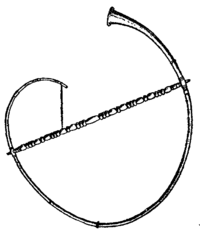
Buccina
 | |
|
This article is part of the series on: Military of ancient Rome 753 BC – AD 476 | |
| Structural history | |
|---|---|
| Roman army (unit types and ranks, legions, auxiliaries, generals) | |
| Roman navy (fleets, admirals) | |
| Campaign history | |
| Lists of wars and battles | |
| Decorations and punishments | |
| Technological history | |
| Military engineering (castra, siege engines, arches) | |
| Political history | |
| Strategy and tactics | |
| Infantry tactics | |
| Frontiers and fortifications (limes, Hadrian's Wall) | |
- Bučina is the name of several locations in the Czech Republic.
A buccina (Latin language: buccina) or bucina (Latin language: būcina), anglicized buccin or bucine, is a brass instrument that was used in the ancient Roman army, similar to the Cornu. An aeneator who blew a buccina was called a "buccinator" or "bucinator" (Latin language: buccinātor, būcinātor).
It was originally designed as a tube measuring some 3.4 to 3.7 meters (11 to 12 ft) in length, of narrow cylindrical bore, and played by means of a cup-shaped mouthpiece. The tube is bent round upon itself from the mouthpiece to the bell in the shape of a broad C and is strengthened by means of a bar across the curve, which the performer grasps while playing to steady the instrument; the bell curves over his head or shoulder.
The buccina was used for the announcement of night watches and various other purposes in the camp.
The instrument is the ancestor of both the trumpet and the trombone. The German word for "trombone", Posaune, is linguistically derived from Buccina.
The buccin was revived during the French Revolution, along with the "tuba curva". Both instruments were first used in the music that François Joseph Gossec composed for the translation of the remains of Voltaire to the Pantheon on 11 July 1791.[1]
In the final section of his orchestral work Pini di Roma (Pines of Rome), Respighi calls for six instruments of different ranges notated as "Buccine" (Italian plural), although he expected them to be played on modern saxhorns or flugelhorns. He also calls for three in the opening movement of his Feste Romane (Roman Festivals), but again notes that they may be replaced by trumpets.[2]
References[]
- ↑ Constant Pierre, Les Hymnes et Chansons de la Révolution française, aperçu général et catalogue, avec notices historiques, analytiques et bibliographiques, 1904, page 210-213.
- ↑ Freed, Richard (Sep 2003). "Program notes to Feste Romane". http://www.kennedy-center.org/calendar/?fuseaction=composition&composition_id=2375.
This article incorporates text from a publication now in the public domain: Chisholm, Hugh, ed. Encyclopædia Britannica Cambridge University Press
External links[]
- Buccina in Smith's Dictionary of Greek and Roman Antiquities.
- Roman Music
| Wikisource has the text of the 1911 Encyclopædia Britannica article Buccina. |
The original article can be found at Buccina and the edit history here.